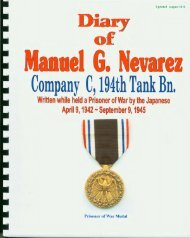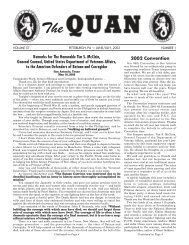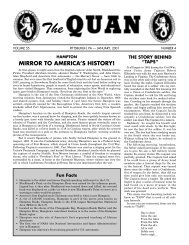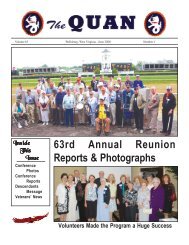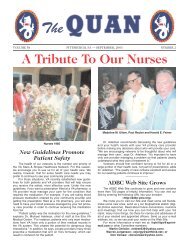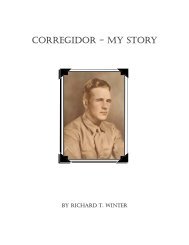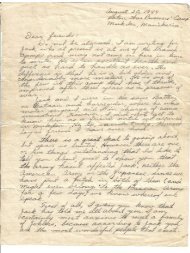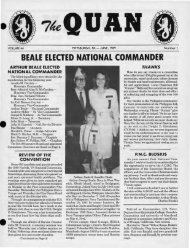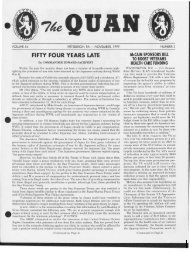95712 Quan Pages:95712 Quan Pages - Philippine Defenders Main
95712 Quan Pages:95712 Quan Pages - Philippine Defenders Main
95712 Quan Pages:95712 Quan Pages - Philippine Defenders Main
Create successful ePaper yourself
Turn your PDF publications into a flip-book with our unique Google optimized e-Paper software.
18 — THE QUAN<br />
Robert C. Allen<br />
Robert C. Allen, engaged in every facet<br />
of Hawaii’s tourism industry for more than<br />
35 years, died May 25 in the Center for the<br />
Aging at Tripler Army Medical Center.<br />
The 92-year-old Kaneohe resident, commonly<br />
referred to as “Bob,” was the president<br />
and director of various organizations<br />
including the Hawaii Visitors Bureau,<br />
Grayline Hawaii and the Hotel Operating Co.<br />
He served as chairman of numerous<br />
tourism committees and co-founded the<br />
Hawaii Skal Club, which consisted of business<br />
leaders in the field.<br />
Allen pioneered Hawaii’s marketing and<br />
sales program by informing travel agents on<br />
the mainland and in Southeast Asia about<br />
the islands’ customs and attributes. He<br />
worked with prominent individuals such as<br />
premier industrialist, Henry J. Kaiser, and<br />
hotel guru, Roy Kelley, to incorporate the<br />
world’s largest catamaran into the Pearl<br />
Harbor sightseeing tour.<br />
His efforts created marketing conditions<br />
that opened the door for future travel in both<br />
directions. The number of Hawaii travel<br />
agents grew from a few hundred directly<br />
after the war to more than 25,000 by 1990.<br />
Allen’s book, “Creating Hawaii Tourism,”<br />
published in 2004, described the events and<br />
people that contributed to the industry’s<br />
dramatic growth and development.<br />
“He was greatly respected within the<br />
tourism industry and was often referred to as<br />
‘Mr. Tourism,’ ” said Ernie Albrecht, former<br />
Skal Club president and Pan American<br />
Airways manager. “I have a tremendous<br />
respect for his ability and what he was trying<br />
to do for the state.”<br />
Albrecht, who knew Allen for about 50<br />
years and referred to him as a “brother,”<br />
often ate lunch with him or watched him<br />
play polo. Allen was a former Hawaii Polo<br />
Club president and frequently played at<br />
local parks.<br />
Prior to Allen’s involvement with tourism<br />
and polo, he attended Southwestern Uni -<br />
versity School of Business Adminis tra tion,<br />
Los Angeles, and became the chief accountant<br />
for a mining company in the <strong>Philippine</strong>s.<br />
While in the <strong>Philippine</strong>s, he served in the<br />
U.S. Navy Reserve and was captured by the<br />
Japanese during World War II. Allen spent<br />
the next three years as a prisoner of war in<br />
two Japanese camps where he met his<br />
future wife, Helene, who is often referred to<br />
as “Billie.” The couple would have celebrated<br />
their 60th wedding anniversary.<br />
“He was a loving husband, caring father<br />
and wonderful grandfather,” Helene Allen<br />
said.<br />
Robert Allen is also survived by<br />
daughters Linda and Sherry, and two<br />
grandchildren.<br />
A private funeral service was held.<br />
————————<br />
~ Deceased ~<br />
Sasoun Samuel Boghosian<br />
Sasoun Samuel “Sam” Boghosian<br />
passed away on Saturday, August 20,<br />
2005 at the age of 84, of natural causes.<br />
He was born on August 2, 1921. He was a<br />
member of the “Greatest Generation”.<br />
Boghosian enlisted in the U.S. Army Air<br />
Corps at the age of 19, in April of 1941.<br />
Shortly after the outbreak of the war, he<br />
was captured and served three and a half<br />
years as a prisoner of war on the Island of<br />
Mindanao in the <strong>Philippine</strong>s, two years of<br />
which he was listed as missing in action.<br />
Following Boghosian’s liberation in<br />
September of 1945, he spent two years in<br />
military hospitals slowly recovering from<br />
the injuries and illnesses he had suffered<br />
during the war.<br />
He then met and married the love of his<br />
life, his “sweetheart” Arpie “Penny”<br />
Kavoukjian, and they had two sons Jeffrey<br />
and Richard.<br />
He was awarded the Purple Heart with<br />
two Oak Leaf Clusters, and 16 other<br />
American and <strong>Philippine</strong> military awards<br />
and decorations, in addition to the Air<br />
Combat Crewman’s Award for Aerial<br />
Gunman Wings.<br />
After military service, Boghosian was a<br />
theatre projectionist for 34 years and<br />
newsreel cameraman for Fox Movietone<br />
News.<br />
He loved his country and continued to<br />
serve it all his life. He was nominated by<br />
Governor George Deukmejian and appointed<br />
by President George H.W. Bush to serve<br />
on the Selective Service Board.<br />
Boghosian was preceded in death by<br />
Arpie “Penny” Boghosian, his loving wife<br />
and “sweetheart” of over 50 years; his son<br />
Jeffrey; his father and mother Ohannes<br />
and Asdik; his sisters, Hasmig Boghosian<br />
and Joan Haroutunian; and his nephew,<br />
John Boghosian.<br />
He is survived by his son Richard;<br />
sisters, Shirley Paboojian of Fresno, and<br />
Joyce Boghosian of Martinez; brothers,<br />
Joe Boghosian of Fresno, Sirag Sam<br />
Boghosian of Indian Wells, and Marty<br />
Boghosian of Montclair, NJ; sisters-in-law,<br />
Hasmig Aaronian and Queenie<br />
Marsoobian; and 13 nieces and nephews.<br />
Visitation was held at Whitehurst,<br />
Sullivan, Burns & Blair Chapel, 1525 E.<br />
Saginaw Way on Thursday, August 25,<br />
2005, from 12:00 noon to 7:00 p.m.<br />
A funeral service was held at Holy Trinity<br />
Armenian Apostolic Church, 2226 Ventura<br />
Street on Friday, August 26, 2005, at 10:00<br />
a.m. Interment followed at Ararat<br />
Cemetery.<br />
————————<br />
Philip Brain, Jr.<br />
By Trudi Hahn<br />
Star Tribune Staff Writer<br />
Philip Brain, Jr. found the purpose he<br />
had promised himself during a grueling<br />
segment of harsh captivity that followed his<br />
capture by the Japanese on the Bataan<br />
Peninsula of the <strong>Philippine</strong>s during World<br />
War II.<br />
He decided to serve, spending 35 years<br />
as an executive with the YMCA and<br />
becoming active in the service group<br />
Rotary International.<br />
Services were held for Brain, of Bloom -<br />
ington. The longtime resident of Edina,<br />
who suffered from dementia, died May 5 of<br />
natural causes involving poor blood circulation,<br />
which may have stemmed from his<br />
wartime deprivations, said his wife,<br />
Deloris, of Golden Valley. He was 89.<br />
Born in Libby, Mont., Brain moved as a<br />
toddler with his family to Minneapolis,<br />
where his father, Phil Brain, Sr., became a<br />
tennis coach for the University of<br />
Minnesota.<br />
Brain, Jr. was a tennis player at Roose -<br />
velt High School and for the University of<br />
Minnesota. He graduated in 1939.<br />
He attended graduate school at George<br />
Williams College in Chicago, and took his<br />
first job with the YMCA at Camp Menogyn,<br />
north of Grand Marais.<br />
He was drafted in April 1941 and, as a<br />
member of the 194th Tank Battalion, which<br />
included many Minnesotans, was among<br />
about 12,000 retreating troops captured a<br />
year later on Bataan by the Japanese. Their<br />
captors forced the troops into what became<br />
known as the Bataan Death March — days<br />
of starvation and fatal brutality for those<br />
who couldn’t keep up.<br />
That was followed by prison camps and<br />
a trip to Japan on a “hell ship,” where prisoners<br />
could not sit or lie down until enough<br />
men died to thin the numbers. In Japan<br />
came the slave labor — for Brain, that<br />
meant descending 478 steps daily into a<br />
copper mine and climbing back out again<br />
at workday’s end.<br />
The Bataan experience “was something<br />
so dreadful that living through it had to<br />
shape a direction in my life,” he said in<br />
1992. “On those prison ships, I decided<br />
that I would try to find a purpose if I ever<br />
got out of them. I think serving is the best<br />
purpose.”<br />
He worked for the YMCA as Camp<br />
Menogyn director, branch executive secretary<br />
and associate general secretary in<br />
personnel, programs, financial management<br />
and financial development.<br />
After his retirement in 1980, he started a<br />
consulting firm to help nonprofit groups<br />
with fundraising. The longtime Mason also<br />
(Continued on Page 19)



